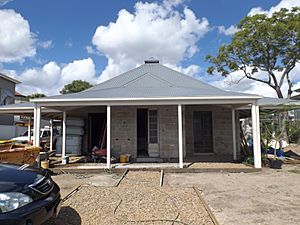Eskgrove facts for kids
Quick facts for kids Eskgrove |
|
|---|---|

Renovations in 2015
|
|
| Location | 56 Laidlaw Parade, East Brisbane, Queensland, Australia |
| Design period | 1840s - 1860s (mid-19th century) |
| Built | 1853 - |
| Official name: Eskgrove, Eskgrove Cottage, Grey Eagles | |
| Type | state heritage (built) |
| Designated | 21 October 1992 |
| Reference no. | 600187 |
| Significant period | 1850s (fabric) 1850s-1870s (historical) 1850s - (social) |
| Significant components | service wing, residential accommodation - main house, extension/s or addition/s |
| Lua error in Module:Location_map at line 420: attempt to index field 'wikibase' (a nil value). | |
Eskgrove is a very old house in East Brisbane, Queensland, Australia. It was built way back in 1853! This special house is also known as Eskgrove Cottage or Grey Eagles. It's important because it's one of the few homes left from before Queensland became its own colony. Today, it's protected as a heritage site on the Queensland Heritage Register.
Contents
The Story of Eskgrove
Building a New Home
Eskgrove was built in 1853 for a man named Archibald Hepburn Hutchinson. He used to be a bank manager in Sydney. Mr. Hutchinson bought the land from a surveyor named James Charles Burnett that same year.
The land was about 12.5 acres (about 5 hectares) and was right by the Brisbane River. A newspaper report from June 1853 probably talked about Eskgrove being built. It said a stone house was being constructed for Mr. Hutchinson near Kangaroo Point.
Early River Estates
In the mid-1850s, there were only three large houses along the Brisbane River in this area. These were Shafston House, Riversdale (now Mowbray Park), and Eskgrove. All three of these important homes were made of stone.
New Owners and Residents
Sadly, Mr. Hutchinson passed away at Eskgrove in 1854. His family then moved back to Sydney. The house became a rental property for many years.
Many important people lived in Eskgrove during Queensland's early days. These included:
- William Kent Jr (1857–58)
- Thomas Lodge Murray-Prior (1858-59)
- Abram Moriarty (1859–60), who was Governor Bowen's private secretary
- Lieutenant George Poynter Heath (around 1861-1865), who was in charge of Queensland's ports
In 1868, a newspaper described Eskgrove as a lovely property by the river. It had six rooms, a kitchen, two servants' rooms, stables, and other buildings. It was set in a large paddock with a kitchen garden.
Changes Over Time
In 1880, William David Nisbet, a chief engineer for harbours and rivers, bought Eskgrove from the Hutchinson family. Later, in 1885, the land was divided up. Thomas Scanlan, a local businessman and mayor, bought the house and about 4 acres (1.6 hectares) of land.
After Mr. Scanlan died in 1892, Eskgrove became a rental property again. Over the years, parts of the house were changed or added to. For example, an old timber wing was replaced.
From 1910 to 1966, the Tritton family owned Eskgrove and made it their home around 1920. Later, the house was used as apartments and even a nursing home called Grey Eagles. Since 1975, it has been a private home again and is once more called Eskgrove.
What Eskgrove Looks Like
Eskgrove is a single-storey house built in the 1850s. It's made of sandstone. Originally, it had a square main part with a room sticking out at the front and a service wing at the back.
Outside Features
The house has a steep roof made of corrugated iron. The outside walls are painted and have a rough texture, but you can still see the original sandstone underneath.
There's a verandah (a covered porch) on three sides of the main part of the house. The front and side verandahs have special columns. There are also French doors with wooden shutters that open onto the verandahs.
Inside the House
Inside, brick walls divide the house into four rooms. The two front rooms share a fireplace. French doors connect the rooms and lead out to the verandah.
The back part of the house, called the rear wing, is also made of stone. In 1985, this wing had three bedrooms. Over the years, other parts like bathrooms and a laundry were added to the back of the house.
Many old trees surround Eskgrove, providing lots of shade. Even with some changes, the house still looks much like it did when it was first built.
Why Eskgrove is Important
Eskgrove was added to the Queensland Heritage Register on 21 October 1992. This means it's a very important historical place.
A Glimpse into the Past
Eskgrove is special because it's one of the few houses left in Brisbane that was built before Queensland became a separate colony in 1859. It shows us how people lived and built homes along the Brisbane River in those early days. It also helps us understand the different types of homes and social groups in early Brisbane.
Rare and Unique
Because it's one of the few surviving homes from before 1859, Eskgrove is considered a rare and important part of Queensland's history.
A Look at Old Building Styles
Eskgrove is a great example of how stone houses were built in Queensland in the 1850s. It also shows how people adapted older building designs, like Georgian style, to suit the climate and lifestyle in Brisbane.
Valued by the Community
Many people in the community value Eskgrove. It's seen as an important part of the early development of East Brisbane and one of the oldest homes still standing in the city.

